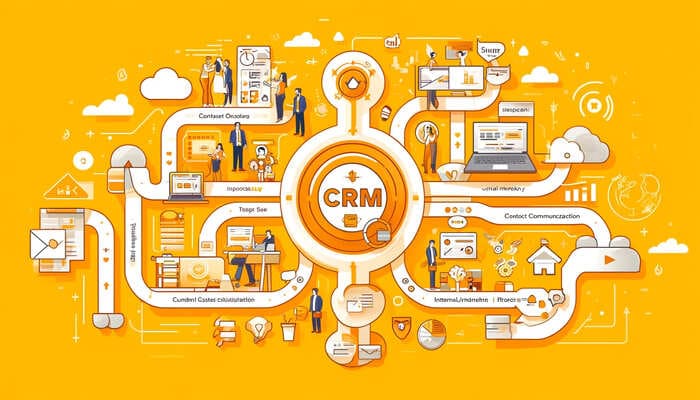Explore the chapters:
Customer data is very crucial in business. Analysing it will help gain insights into the preferences and behaviours of both existing and potential customers, enabling companies to tailor their marketing efforts more effectively. However, managing this wealth of data can be a daunting challenge. This is where Customer Relationship Management Integration comes into play.

Every business is thriving for an online presence. So, companies are using a lot of applications for day-to-day operations. Customer Relationship Management Integration ensures the data flows seamlessly between those tools
With CRM Integration, you can analyse the data, understand your customers and streamline processes improving the customer experience.
Let’s say you have a website form collecting the leads data, an email marketing platform to send email newsletters and communication and social media platforms to stay connected and brand awareness.
Imagine managing these manually with data management. How daunting the task will be if you were to do it manually? This is where CRM integration comes in handy.
CRM starts with updating the user details on form submission, then tracking the clicks in the emails you send and interaction with your brand on social media giving you great scope for lead scoring to send more personalized and targeted messaging.

CRM acts as a centralised hub for all your business and customer data giving you a complete picture. You can easily find customer preferences, past interactions, and internal communications which will help you draw and identify patterns in your business to anticipate business opportunities in the future and leverage them.
Other benefits of CRM integration include,
By integrating CRM into your operations, you establish a unified customer view, empowering you to anticipate inquiries, engage with leads more efficiently, and tailor marketing efforts accordingly.
For instance, consider an IT consulting firm where a potential customer navigates their website, ultimately clicking the “Contact Us” button.
Once the potential customer fills out the contact form, providing details about their product interests and specific needs, this information is automatically stored in your CRM for easy access by your team.
Your sales team can leverage this data to personalize their initial outreach, offering tailored solutions proactively. Simultaneously, your email marketing system can trigger nurture streams aimed at promoting the prospect’s product of interest. Additionally, your social media manager can refine ad content based on insights gleaned from the CRM.
This comprehensive approach increases the likelihood of engaging potential customers throughout their buying journey, ultimately enhancing the chances of conversion.
CRM integrations facilitate internal collaboration by providing quick access to necessary information, saving time and reducing confusion.
For instance, Pipedrive’s Dealbot, a CRM integration for Slack, consolidates internal discussions related to sales status. Setting up Dealbot is straightforward: create a new Slack channel and add participants.
Once linked, the channel receives Slack notifications for any sales pipeline updates. This ensures that relevant team members are promptly notified and can respond accordingly, keeping everyone aligned and informed.
CRM integration makes your workplace more efficient with real-time access to data.
You know your customer’s needs right away, so you don’t have to ask the same questions repeatedly.
Once you decide to use a CRM integration software, you will want to choose the best one. Top CRM providers offer advanced tools such as document management, lead scoring, and quote estimates including basic features like managing sales pipelines and generating reports. Choosing the right CRM depends on your specific needs. Here’s a list of the top 11 CRM providers, outlining their features, benefits, pricing, and ideal use cases to help you decide.
Zoho CRM is a comprehensive and budget-friendly tool for managing sales and marketing tasks. It offers a free plan for up to three users and paid options ranging from ₹800 to ₹2600 per user, per month when billed annually. Alongside basic sales pipeline management, it provides advanced features like lead scoring, sales forecasting, and email templates. Although additional features like unlimited storage and price quotes may require extra payment, Zoho CRM integrates well with other Zoho platforms like help desk and accounting services.
Who should use it: If you’re searching for reliable CRM software with a lot of sales and marketing features at an affordable price, Zoho CRM could be the ideal choice for you.
Pros
Cons
Pipedrive is a scalable and practical CRM solution with plans starting at $14 per seat per month and going up to $99 per seat per month, making it accessible for various business sizes. The entry-level plan includes essential CRM features like lead and pipeline management, while higher-tier plans add sophisticated capabilities such as automation builders, email tracking, AI-driven tools, and comprehensive project management features. Add-ons for website visitor tracking, lead generation, email marketing, document management, and project management can be included for an extra fee, allowing businesses to pay only for the features they need. Pipedrive also offers support in 22 languages, an online help center, chatbot support, and personalized assistance options based on seat requirements.
Who should use it: Pipedrive is ideal for businesses that need flexible, visual tools for managing sales processes and prefer a pricing model that allows them to scale features according to growth.
Pros
Cons
Salesforce CRM is one of the most robust customer management systems, known for its vast customization capabilities and advanced analytics and reporting. It is an ideal solution for established businesses looking for a comprehensive, all-in-one CRM and sales data platform to optimize the sales process and increase revenue. Key features include lead management, advanced workflows, customizable sales pipelines, forecast management, quotes, contracts, lead auto-assigning, bulk email sends, marketing campaign management, and advanced analytics and reporting. Salesforce stands out for its high degree of customization, ease of use, and integration with over 1,000 other platforms. However, some advanced analytics and reporting features come at an additional cost of $75 per user per month. Pricing starts at $25 per month, with higher tiers offering more advanced features. Salesforce provides support via phone and chat, with options for callback requests.
Who should use it: Larger sales teams or businesses needing advanced sales reporting, pipeline customizations, and collaboration features will find Salesforce particularly beneficial.
Pros
Cons
HubSpot CRM is a versatile tool renowned for its robust sales and marketing features, making it a top choice for businesses of all sizes. Its ability to scale with a business through its free, low-cost, and comprehensive enterprise-level plans makes it ideal for various growth stages. Key features include form automation, list segmentation, live chat, and SEO recommendations, which help businesses efficiently generate leads, manage customer relationships, and market effectively. HubSpot’s unified dashboard integrates marketing, sales, customer service, operations, and commerce functionalities, reducing the cost and complexity of managing multiple stand-alone tools. The platform’s detailed list segmentation enables granular targeting for personalized marketing strategies. Pricing starts at $0 for the free plan (up to five users), with the Starter plan costing $15 per seat per month, offering essential marketing tools like landing pages, email marketing support, and live chat. HubSpot’s flexible pricing and feature options cater to a wide range of business needs.
Who should use it: Businesses that want to integrate their sales, marketing, and service teams on one platform will find HubSpot particularly beneficial.
Pros
Cons
Close is a sales engagement CRM designed for SMBs to convert more leads into revenue, ideal for agile, remote teams needing scalable solutions without high costs. It combines email, call, and text communication into one inbox.
Packed with productivity tools like custom workflows, Call Assistant, Predictive Dialer, and cold email automation, Close helps teams reach more leads, follow up more often, and grow revenue quickly. Features include lead management, global calling management, 2-way email sync, reporting, built-in text messaging, sales pipeline view, and email marketing tools. Its bulk email automation and predictive dialing support high-volume sales, and it integrates with over 50 applications, including Zapier, Zendesk, and Wufoo.
Who should use it: Close is perfect for tech-enabled, remote-working teams that need a powerful, efficient sales tool to scale without the high costs of enterprise software.
Pros
Cons
NetHunt is a sales automation tool that integrates seamlessly with Gmail and Google Workspace apps, allowing companies to organize contacts and deals, build custom pipelines, automate sales processes, and monitor team effectiveness. Key features include lead capture, prioritization, drip campaigns, email linking, notifications, and custom pipelines, along with comprehensive reporting and integrations with popular tools like Google Contacts, Intercom, and LinkedIn.
Who should use it: NetHunt is perfect for businesses seeking to automate their sales processes within Gmail and Google Workspace, streamline lead management, and enhance team collaboration and efficiency.
Pros
Cons
Nimble CRM distinguishes itself by seamlessly integrating social media into its core functionality. Unlike many other CRMs that treat social media as an afterthought or add-on, Nimble centralizes it, providing features like social profile matching and enrichment directly within the platform. By automatically fetching and integrating information from various social networks into contact records, Nimble offers businesses a comprehensive 360-degree view of their clients and prospects, enabling richer context and more meaningful engagement points.
Who should use it: Nimble CRM is perfect for those seeking a no-frills solution with straightforward pricing and robust prospecting features.
Pros
Cons
Nutshell is an all-in-one CRM and email marketing platform designed to empower B2B organisations to win more deals collaboratively. Simple enough for any user and sophisticated enough for any business, Nutshell streamlines the sales and marketing process for teams tired of managing separate tools. With Nutshell, businesses can avoid the need for a full-time admin to handle software management. Every Nutshell subscription includes unlimited CRM contacts and data storage, fully customizable reporting tools, free data migration assistance, and world-class live support, all at an extremely affordable price.
Who should use it: Nutshell is ideal for B2B organisations seeking an affordable, all-in-one solution to streamline sales and marketing processes. It is perfect for teams looking to eliminate the hassle of managing separate tools and avoid the need for a full-time admin. Additionally, businesses already using software like Google Workspace/Gmail, Microsoft Office/Outlook, QuickBooks Online, Intercom, and Slack will find Nutshell’s seamless integration beneficial.
Pros
Cons
Membrain is the leading sales effectiveness platform designed to drive the necessary behaviours in complex B2B sales to enhance sales effectiveness and achieve consistent performance. It equips your team with the tools needed to adopt these behaviours, ensuring they consistently reach their sales targets. Membrain is flexible enough to replace, run alongside, or integrate with your traditional CRM.
Who should use it:
Membrain is perfect for B2B organisations engaged in complex sales processes that need to drive effective sales behaviours and ensure consistent performance. It is ideal for teams looking to enhance their sales effectiveness and achieve their sales targets, whether they are looking to replace, complement, or integrate with their existing CRM system.
Pros
Cons
Ontraport is a robust platform designed to enhance online sales conversions through funnels and automation. It efficiently handles all the assets and pages needed to build a business that operates on autopilot. Ontraport enables businesses to capture new leads from various channels, guiding them through content that educates them about your products and services, ultimately leading to conversions or scheduled calls with prospects.
Who should use it: Ontraport is ideal for online businesses seeking to improve conversion rates through sophisticated funnel setups and automation. It is perfect for those who want to capture leads from multiple channels and guide them through personalized sales journeys. Businesses looking for a platform with robust CRM capabilities, extensive data tracking, and seamless integration with payment systems will benefit greatly from Ontraport.
Pros
Cons
Salesmate is a highly customizable CRM designed for businesses with unique sales processes or niche markets. Its intuitive drag-and-drop interface allows users to arrange information according to their preferences, placing critical data at the forefront and less important details out of view. This flexibility extends to forms and custom modules, enabling deep customization to suit various roles and data management needs.
Who should use it: Salesmate is perfect for businesses with unique sales processes or those operating in niche markets that require extensive customization. It suits teams looking for a CRM that can adapt to their specific workflow needs, providing flexibility in data management and user interface. Additionally, businesses needing integrated project management capabilities within their CRM will find Salesmate particularly beneficial.
Pros
Cons
Schedule a free consultation call with our team today

Integrating Customer Relationship Management (CRM) applications, whether they are proprietary or from third-party vendors, can significantly enhance the efficiency and effectiveness of your business operations. Let’s explore the various integration options along with their benefits and suitability for different scenarios.
Native integrations refer to pre-built connections within the same software ecosystem, such as your CRM system. These integrations are designed to seamlessly synchronize data and functionalities without requiring extensive technical expertise or custom development.
Key Benefits:
Who is it for?
Native integrations are ideal if your CRM platform aligns with the tools you currently use or plan to incorporate. They are often cost-effective, as they may be included in your subscription or available at a lower cost compared to third-party solutions.
Third-party connectors bridge the gap between your CRM and external applications via APIs, offering extended functionalities beyond the CRM’s native capabilities.
Key Benefits:
Who is it for?
Third-party connectors are suitable for businesses seeking to enhance CRM functionality with specialized tools. They offer scalability without disrupting existing systems, making them adaptable to evolving business needs.
Third-party APIs are standardized solutions provided by external vendors, offering direct communication and data exchange between your CRM and various tools.
Key Benefits:
Who is it for?
Third-party APIs are recommended for businesses with unique integration requirements. While they offer greater flexibility and customization, they necessitate technical expertise for implementation due to coding and programming involvement.
Custom APIs are tailor-made solutions developed in-house to connect your CRM with external tools, providing a bespoke approach to integration.
Key Benefits:
Who is it for?
Custom APIs are well-suited for businesses with distinct workflow requirements or reliance on niche, industry-specific tools. They offer a high level of control and can effectively integrate specialized software, ensuring seamless operation and data management.

Integrating CRM seamlessly into your business operations requires more than just technological know-how. It’s about aligning your integration efforts with your overarching business objectives to drive growth and success. Here are some best practices to ensure a smooth and effective integration process:
Clearly outline the specific outcomes you aim to achieve by integrating your CRM with other tools. This alignment ensures that your integration efforts directly contribute to your business goals. For instance, if your objective is to enhance customer engagement through targeted email campaigns, prioritize seamless data flow from your CRM to your email marketing platform. This enables personalized communication based on customer behavior, like reminding patrons of weekend specials at a pizzeria.
Ensure the accuracy and reliability of your CRM data by implementing proper data hygiene practices. Regularly clean your CRM database to eliminate duplicate entries and outdated information. Utilize data cleaning tools such as OpenRefine, Akkio, and WinPure to automate this process, ensuring that the data powering your tools remains error-free.
Equip your team members with the necessary knowledge and skills to effectively utilize the integrated CRM system. Proper training enables them to understand the purpose and functionalities of the CRM integration, empowering them to leverage its full potential. This maximizes benefits and minimizes risks associated with integration.
Even with careful planning, unforeseen challenges may arise during CRM integration. Conduct regular assessments of the integrated system’s performance and functionality. Continuous monitoring allows you to detect and address glitches early on, reducing operational disruptions and ensuring a smooth user experience.
Integrating CRM seamlessly enhances collaboration, facilitates informed decision-making, and elevates customer experiences. The choice of integration tools depends on your business needs, existing software ecosystem, and desired level of customization and control.
Ever wondered how you can transform your email marketing strategy to not only build trust with your audience but also tap into new opportunities and drive tangible results? In the next chapter, we learn how to take your email marketing efforts to new heights.
Chapter 4.2: Track ROI Through Marketing Analytics Dashboards
638 Independence Parkway, Suite 240, Chesapeake, Virginia, USA – 23320
3 Eurospace, 4th Floor, Jyothi Imperial, Janardana Hills, Gachibowli, Hyderabad, Telangana, India – 500032
Mileta Sorokovska, Moosstrasse 19,
6003 Luzern, Switzerland
Copyright © 2024 by StartupWize